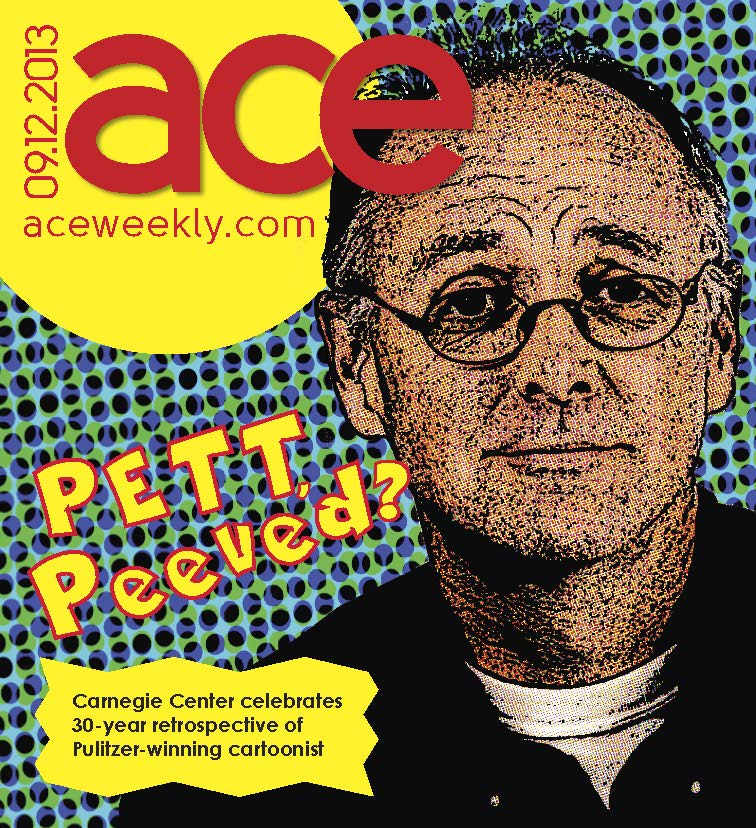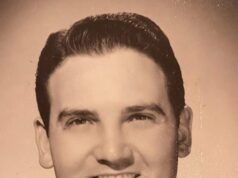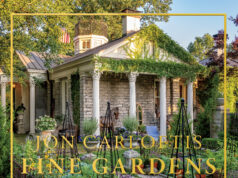By Kakie Urch
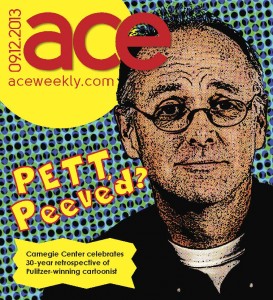


Joel Pett has been the political cartoonist for the Lexington Herald-Leader since 1984, a tenure of 29.5 years, an even 30 in April.
In one of those years –2000 — he won the Pulitzer Prize for Editorial Cartooning. In three other years, he was named a finalist for the Pulitzer. Nearly every single day of those 30 years, Joel Pett has been seriously peeved about something and presented his opinion in the pages of Kentucky’s McClatchy daily.
And also nearly daily, Pett and his distinctive cartoon style are cursed, praised, cut out, posted on fridges, forwarded on Facebook, Retweeted (with or without curses or “Amens”). Love him or love to hate him, Joel Pett is a trope in Kentucky politics and public life.
I was an intern in the editorial department in the 1980s. Joel Pett called me “The New Puritan,” because I would stick my fingers in my ears when the newsroom banter turned blue. And I’m not talking Big Blue Nation.
A 30-Year Retrospective of his work will hang in the Carnegie Center for Literacy and Learning in downtown Lexington this Fall, with an opening reception on Sept. 18.
I’ve known Pett for nearly all the years he’s been peeved and publishing. He’s one of 55 editorial cartoonists working in the U.S. — a field that used to be comprised of hundreds. I asked him some of the questions that readers (fans or not) might have about his career.
Who hired you?
“David Holwerk, God bless him, who took a chance on an application from a 30-year-old stoner dropout out of all 120 of them, including one from Bill Watterson, who would go on to draw ‘Calvin and Hobbes.’ I will be forever indebted to him for that.”
Holwerk’s boss at the time was Executive Editor John Carroll, a former Vietnam War correspondent. Holwerk has three or four Pulitzer Prizes to his name, from work at the Herald-Leader and the Sacramento Bee. Carroll has, depending on how you count them, 14 Pulitzers, from his cumulative work at the Herald-Leader, the Baltimore Sun and the Los Angles Times. The newspaper editor character in “The Wire” is said to be inspired by John Carroll. So, the two guys with the most Pulitzer Prizes ever to come out of the Herald-Leader picked Joel Pett.
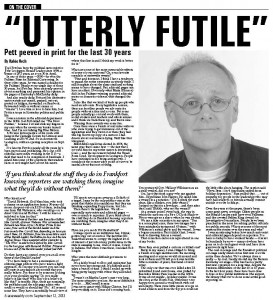


Do they have any control over you at all over there at the Herald-Leader?
“I’ve been lucky to have a succession of editorial page editors who have taken a light approach. As I’m sure you know, you can only advocate in any fashion about stuff that you really believe. For there to be someone looking over your shoulder saying ‘Do you really believe it like that? Why don’t you believe it like this?” is terrible. Sure, there are nominally the publisher and the edit page editor who could or would or should say ‘No,’ if I crossed some line. They have a mercifully broad view of where that line is and I think my work is better for it.”
What are some of the more memorable effects of some of your cartoons? Or, your favorite scandals or statewide events?
“First and foremost, I think I have a tendency to regard the entire enterprise as utterly futile. I still complain about the same stuff and nothing seems to have changed. But, editorial pages can have an effect. Obviously what Maria (Henson) did (in her Pulitzer-winning reported editorial series on domestic violence) that changed the law.
I also like that we kind of buck up people who need an advocate. Every legislative session, there are frontline people we advocate for people without a face and a voice. But some people actually go out and work with them, social workers and teachers and whole armies and I think we buck them up, and that is nice.
Winning those awards was some fun.
Once there were a bunch of coal mine widows who were trying to get insurance out of the legislature and they went over there they had this big blown-up copy of a cartoon I had drawn about coal miners dying. Stuff like that was great.
Mitch McConnell was elected in 1984, the same year that I came here — the fact that I covered him for my entire career is interesting. Coal — and the movement behind the Broad Form Deed. Development in Lexington. People have criticized us for being anti-growth. I consider it the conservative point of view to be careful about that sort of thing.
UK sports never goes away as a Goliath of a target. I may be the only public voice at the point that thinks it is scandalous that they are thinking expanding Rupp Arena, but I do.
Then there’s the legislature. We all — especially cartoonists and editorial pages — owe so much to reporters. If you think about the stuff they do in Frankfort knowing reporters are watching them, imagine what they’d do without them?


College sports as an institution has, I think, gotten way out of control. The fact that UK basketball seems to occupy the highest level of interest of just about any public issue in the state is amazing to me. And of course, I went to Indiana. But when I was there, I mocked Bob Knight.
You must be the U.S. cartoonist who the most often features Africa in your work. Consistently throughout your career, amongst the coal and the basketball and the Derby and plaid sportcoats, up pops a cartoon about Africa.
You can only really write about stuff that you’re passionate about. That’s what every writer does. There’s no secret to it. It’s obvious that my formative years, spent over there, impact the topics that I choose.
The one African cartoon that jumps to mind is in the presidential campaign of Obama v. McCain, during the week leading up to the foreign policy debate, there was this huge news about the worst famine ever…. on the Horn of Africa. In the foreign policy debate, moderated by Jim Lehrer. It just didn’t come up. It was the biggest, most heartwrenching thing ever and it was just like no national reporter thought about bringing that up.
I’ve got my national market in mind when I do some of the Africa stuff. I have to tell you, I wonder if the local readers wonder where is this coming from? “Oh by the way, Eritrea.”
All I can be is myself and that was a part of it.
Pett moved to Nigeria at age 5 along with his family, as his father an Audio Visual Media professor at University of Indiana was involved with a USAID project to put together AV programs in universities and also build educational television in Nigeria. He lived in Africa until he was 11.
Who were the most difficult governors to draw?
It’s a fairly broad toolbox and caricature has never been my strong suit. It’s difficult and it takes a bunch of time. I think I ended up with being pretty happy with where they all ended up.
I wasn’t on Martha Layne’s case very long. The more attractive you are, the more difficult it is to do…..McConnell is easy.
I was never great with Hillary Clinton, but I’ll keep working on it. I hear she’s coming back.
You portrayed Gov. Wallace Wilkinson as an actual weasel, did you not?


I seized on that for a few days…and then after that I said ‘Ehhhh, why not the weasel?’
At a certain point I went back, the way in which the cartoons of a Five O’Clock Shadow Nixon were given a shave when he was elected.
We ran a fake correction in my space: “Due to a conceptual error, these two images have been mistakenly juxtaposed 63 times,” with Wilkinson’s actual photo and the weasel. It was a bogus correction. But it didn’t last. I went back to drawing him as a weasel.
That correction cartoon is reproduced in one of my books.
Have they ever pulled a cartoon or killed one?
Early in my career, I was obliged to bring a bunch of rough sketches into the morning meeting and everyone would sit around and look at them and I’ll tell you it was terrible.
After a number of years, that kind of went away.
The only one that was ever killed after I’d submitted it and went home, was pulled by Executive Editor Pam Luecke in the 1990s.
It was about suicide…holiday suicide. It was the elves at the North Pole, with three very happy elves around a workbench with one seat empty. There were little pieces of rope on it and scissors and from the top you could see the little elfin shoes hanging. The caption said “News Item: 1 in 4 Americans suffers from holiday depression.” Pam pulled that ….. out of empathy for people in the readership who may have had relatives or friends actually commit suicide over the holidays.


I was mentioning before how much cartoonist and editorial pages depend on reporters. I’ve been so lucky to have worked beside — it must be hundreds by now — many of whom have gone on to do such great work and have done great work right here.
The coal coverage and the Frankfort political coverage really stand out as first-rate over the entire three decades. We’ve always done a really — by coal, I really should say the Eastern Kentucky coverage–This has been a pretty first-rate operation for a long time, despite the business difficulties of the last 10 or 15 years. In the last four years, there have been close to four or five public institutions (the airport, the library) that we’ve done some awful good reporting on.
If a young person wanted to dive into the classics of political cartooning, which names would you offer as a starting place?
“I’m not a scholar but Thomas Nast, then the WWII guys, Bill Maulden, Herblock. Back then, there were 350 cartoonists. The genre was a little different. It wasn’t as nasty. Paul Conrad came along in the 60s. Oliphant did some serious asskicking. In the ‘70s, the post-Watergate guys, Tony Auth, Doug Marlette Mike Keefe, Garry Trudeau and Jeff MacNelly. (MacNelly was noted for his newsroom culture comic strip “Shoe” but was still doing regular editorial cartoons at the time of his death, despite the strip’s popularity).
“He was a conservative too. He was like the first guy to be really smart and good and funny and conservative.
“Right now I think that there’s only one real artistic genius working and that’s Oliphant. He does things with weight, dimension, perspective and architecture that no one can do. Also, Tom Toles of the Washington Post, as a writer, because cartoonists are writers too. His deceptive simplicity and the strength of that approaches genius.
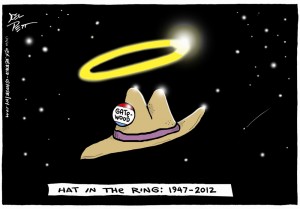

I think there was more collegiality…I’m thinking about the political body. One of the things that I fear as I get older is that I’m going to be the things-were-better-before-the-iPhone Guy. But despite that, this division and the moves to shut the government down over and over on ideological grounds. I don’t remember it being like that. Passion is one thing and its great, but abject hatred is not. It’s occurred to me more than once that political cartoons are a lousy vehicle for the message of “Let’s all make peace.”
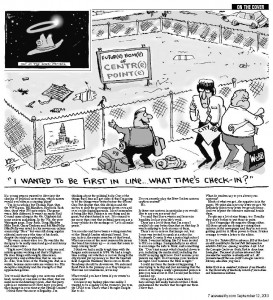


You are also and have been a voting member of the Herald-Leader editorial board. You are, in fact, the senior member of that board. What are some of the most memorable issues the board has taken up — or ones that seem to keep coming back?
I think we had a really tough time with the Reagan endorsement in 1984. We had a tough time sorting out whether or not we thought the city should put up money so that the baseball field (Legends Stadium) that is out on North Broadway should be downtown. We endorsed Rand Paul in the primary over Trey Grayson. That was not unanimous, let us say.
What would you have been if you weren’t a cartoonist?
You know my backup plan was caddy. I wanted to be a caddy on the women’s pro tour, the LPGA tour. That’s what I thought I might like to do.
Do you secretly play the New Yorker cartoon caption contest?
No.
Is there one cartoon in particular you would like to say you are sorry for?
I’ve said that If you want a real lesson in humility, look at your life’s work.
There are a lot of them that I’m sorry I couldn’t do any better than that on that day. It was horrifying to look at some of them.
There’s not a cartoon that jumps out, but I once was invited to speak at a school in Rockcastle County. It was a junior high school I think. I was just talking like I’d been invited to UK or a college. I misguidedly in an effort to encourage the kids to think, said something like “Don’t just accept what’s handed down to you, including the media stuff, including the stuff I’m saying right now. Don’t assume your parents are right. Don’t assume your teachers are right. Don’t assume the Bible is right.”
I could just hear the freakout happening. I was trying to be flip and just assuming that the lesson of inviting a really opinionated person is later you talk about it. But I could just feel that I messed up.
Oh my God, I got a letter a week later. I have always felt really bad about that. I think embarrassed the teacher that brought me there. I blew that.
What do readers say to you about your cartoons?
Much of what we get…the negative is in the paper. We print almost every letter we get. We definitely print every letter we get about me. And we reprint the offensive material beside them.
People say a lot of nice things, too. Usually they don’t bother to put those in print.
I don’t begrudge the negative things either. All those people are doing is voicing their opinion in the newspaper and they’re not even getting paid for it. More power to them. It takes courage to write a letter to the editor.
Tickets ($10 in advance, $15 at the door) are still available for the Joel Pett Retrospective exhibit’s 5:30 p.m. opening reception Sept. 18 at the Carnegie Center on Gratz Park in downtown Lexington. The panel of cartoonists event that precedes the reception is already sold out. All proceeds benefit the non-profit Carnegie Center’s literacy, education programs.
Kakie Urch is an assistant professor of multimedia in the University of Kentucky School of Journalism and Telecommunications, and an Ace contributing editor.
This interview appears on page 6 of the September 12, 2013 print edition of Ace.
Click to subscribe to the Ace digital e-dition, and get Lexington news delivered to your inbox every Thursday morning.


